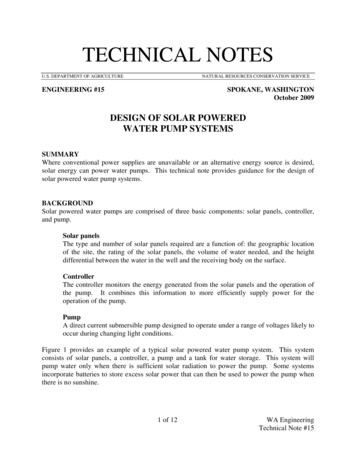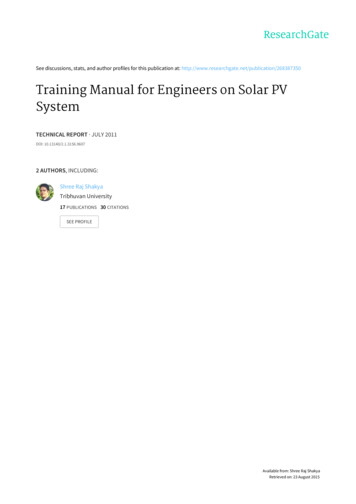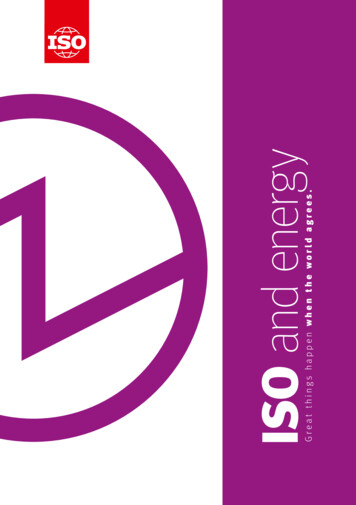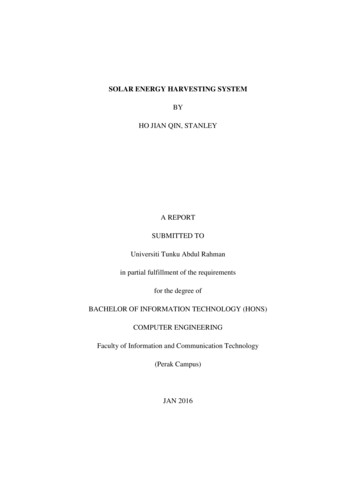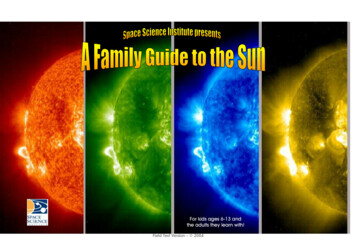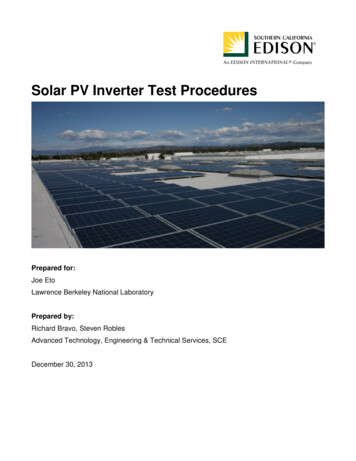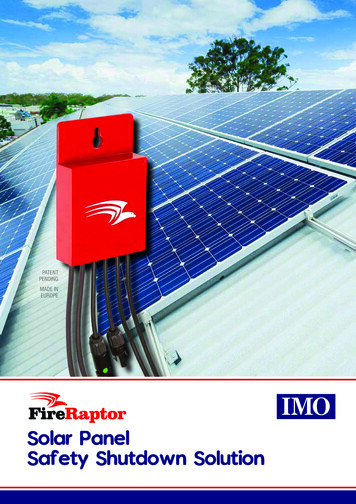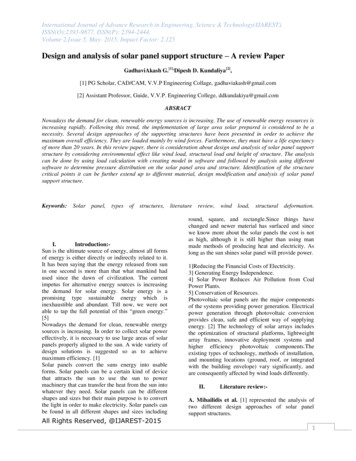
Transcription
International Journal of Advance Research in Engineering, Science & Technology(IJAREST),ISSN(O):2393-9877, ISSN(P): 2394-2444,Volume 2,Issue 5, May- 2015, Impact Factor: 2.125Design and analysis of solar panel support structure – A review PaperGadhaviAkash G.[1],Dipesh D. Kundaliya[2],[1] PG Scholar, CAD/CAM, V.V.P Engineering Collage, gadhaviakash@gmail.com[2] Assistant Professor, Guide, V.V.P. Engineering College, ddkundakiya@gmail.comABSRACTNowadays the demand for clean, renewable energy sources is increasing. The use of renewable energy resources isincreasing rapidly. Following this trend, the implementation of large area solar prepared is considered to be anecessity. Several design approaches of the supporting structures have been presented in order to achieve themaximum overall efficiency. They are loaded mainly by wind forces. Furthermore, they must have a life expectancyof more than 20 years. In this review paper, there is consideration about design and analysis of solar panel supportstructure by considering environmental effect like wind load, structural load and height of structure. The analysiscan be done by using load calculation with creating model in software and followed by analysis using differentsoftware to determine pressure distribution on the solar panel area and structure. Identification of the structurecritical points it can be further extend up to different material, design modification and analysis of solar panelsupport structure.Keywords:Solar panel,types of structures,I.Introduction:Sun is the ultimate source of energy, almost all formsof energy is either directly or indirectly related to it.It has been saying that the energy released from sunin one second is more than that what mankind hadused since the dawn of civilization. The currentimpetus for alternative energy sources is increasingthe demand for solar energy. Solar energy is apromising type sustainable energy which isinexhaustible and abundant. Till now, we were notable to tap the full potential of this “green energy.”[5]Nowadays the demand for clean, renewable energysources is increasing. In order to collect solar powereffectively, it is necessary to use large areas of solarpanels properly aligned to the sun. A wide variety ofdesign solutions is suggested so as to achievemaximum efficiency. [1]Solar panels convert the suns energy into usableforms. Solar panels can be a certain kind of devicethat attracts the sun to use the sun to powermachinery that can transfer the heat from the sun intowhatever they need. Solar panels can be differentshapes and sizes but their main purpose is to convertthe light in order to make electricity. Solar panels canbe found in all different shapes and sizes includingliteraturereview,windload,structural deformation.round, square, and rectangle.Since things havechanged and newer material has surfaced and sincewe know more about the solar panels the cost is notas high, although it is still higher than using manmade methods of producing heat and electricity. Aslong as the sun shines solar panel will provide power.1]Reducing the Financial Costs of Electricity.3] Generating Energy Independence.4] Solar Power Reduces Air Pollution from CoalPower Plants.5] Conservation of Resources.Photovoltaic solar panels are the major componentsof the systems providing power generation. Electricalpower generation through photovoltaic conversionprovides clean, safe and efficient way of supplyingenergy. [2] The technology of solar arrays includesthe optimization of structural platforms, lightweightarray frames, innovative deployment systems andhigher efficiency photovoltaic components.Theexisting types of technology, methods of installation,and mounting locations (ground, roof, or integratedwith the building envelope) vary significantly, andare consequently affected by wind loads differently.II.Literature review:-A. Mihailidis et al. [1] represented the analysis oftwo different design approaches of solar panelsupport structures.All Rights Reserved, @IJAREST-20151
International Journal of Advance Research in Engineering, Science & Technology(IJAREST),ISSN(O):2393-9877, ISSN(P): 2394-2444,Volume 2,Issue 5, May- 2015, Impact Factor: 2.125 Fixed support structure design. Adjustable support structure design.They did analysis according to the following steps.1) Load calculation, 2) Analysis of the structure,which includes the creation of a Finite element modelusing ANSA as preprocessor. Loads calculated in thefirst step are applied to the model. As solver MSCNastran is used.3) Identification of the structurecritical points. According to the results weak pointsare redesigned in order to increase the end.Fig [3]. Solar panels withoutsolar panels with parapet [2]Figure [1]:- Stress in fixed design [1]Figure [2]:- Stresses in adjustable design [1].Jinxin Cao et al. [2] performed a wind tunnelexperiment to evaluate wind loads on solar panelsmounted on flat roofs. In order to find module forcecharacteristics at different locations on the roof theyuse solar array which were fabricated with pressuretaps. They consider two different cases 1] singlearray, 2] multi-array and find mean and peak moduleforce co-efficient. They also find effect of meanmodule force co-efficient on design parameter ofsolar panel. They found effect of mean module forceco-efficient on design parameters (tilt angle, height)of solar panel. The results show module force coefficient for single array cases is larger than multiarray cases.parapet[2]Chih-Kuang Lin et al. [3] use FEA approach to findthe effects of self weight and wind loads on structuraldeformation and misalignment of solar radiation.They consider distribution of stress and deformationwith wind speed 7and 12with variousblowing directions including gravity. The resultshows that this CAE technique is applicable fordesigning a reliable and efficient trackingphotovoltaic system. Highly stressed regions arelocated at bushing and ball bearing & according tovon-mises criterion there is no structural failure forgiven photovoltaic system. The result also indicatedisplacement and angular displacement increase withan elevation angle for wind directions at ,, andbut it will started decrease with wind direction ofandAll Rights Reserved, @IJAREST-20152
International Journal of Advance Research in Engineering, Science & Technology(IJAREST),ISSN(O):2393-9877, ISSN(P): 2394-2444,Volume 2,Issue 5, May- 2015, Impact Factor: 2.125Fig [6]: CFD mean pressure coefficients on acenter line going over upper and lower surfacesfor scales1:50, 1:20, 1:10 and 1:1 along with datafrom a physical BLWT experiment carried out ona 1:10 scaled model.[4Fig [4]: Displacement Vs elevation angle (windspeed 7)[3]Fig [7]:Contour plot of CFD mean velocity (m/s)around a model scaled 1:50.[4]Fig [5]:Displacement Vs elevation angle (windspeed 12)[3]AlyMousaadAly et al. [4] built testing models oflarge civil engineering structures at geometric scale1:500 to 1:100. They were producing an aerodynamicmodel of solar panel subjected to wind load andmounted on ground. Testing can be carried outexperimentally (in boundary layer wind tunnel) andnumerically (by computational fluid dynamics) atdifferent geometric scale. The result shows that forvery small size solar panels are having different meanloads as they are located very close to ground.Alex Mathew et. al. [5] Worked on design andstability analysis of solar panel support structuremade out from mild steel. They conducted this workas a part of project of Mahindra Reva Ltd. Named as“solar 2 car”. The result shows that the solar panelsupport structure can able to sustain a wind load withvelocity 55. They calculated required amount ofweight to withstand wind load for different windzones without any holding arrangements and thenafter optimization can be done for easy assembly,dismantle and transportationAll Rights Reserved, @IJAREST-20153
International Journal of Advance Research in Engineering, Science & Technology(IJAREST),ISSN(O):2393-9877, ISSN(P): 2394-2444,Volume 2,Issue 5, May- 2015, Impact Factor: 2.125Fig [8]: CAD Model of solar panel supportingstructure with parameters in CREO software. [5]Georgeta Vasies et al. [6] presented Numericalsimulations for analysis of wind action on solarpanels located on flat roofs with and withoutparapets. Numerical simulations are performed inANSYS CFX, for an incidence wind angle of45 .they are watching that Oblique direction of windgenerating high intensity of uplift forces in the cornerareas of the flat roof, forces which bring an additionalload on support systems of solar panels. Presence ofthe parapet help mitigate the wind loads, and averagepressure is up to 18.6% lower that for solar panelsplaced on flat roof without parapet.Fig[9]: central zone of solar panels rows,building without parapet.[6]forFig [10]: Central zone of solar panels rows, forbuilding with parapet [6]Girma T. Bitsuamlaka et al. [7] presented theaerodynamic features of ground-mounted solar panelsunder atmospheric boundary layer. They did fourdifferent test cases to determine the wind effects onstand-alone ground mounted solar panels differingfrom one another by wind angle of attack and numberof panels. They verified that there is reduction inwind loads on the adjacent solar panel when they arearranged in tandem. After that they were concludethat „the solar panels experienced the highest overallwind loads forwind angle of attack‟Fig [11]: mean velocity contours forattack [7]angle ofVijay B. Sarode et.al. [8] represented the design andoptimization of solar panel support structure which ismade up form steel. They proposed to introducelatest FEA knowledge and concepts to work on thissector to provide a detail optimized design.So theyhad created the model in PRO-E software. They weredoingAfter creating model of support structure theydid analysis of structure by choosing different cross-All Rights Reserved, @IJAREST-20154
International Journal of Advance Research in Engineering, Science & Technology(IJAREST),ISSN(O):2393-9877, ISSN(P): 2394-2444,Volume 2,Issue 5, May- 2015, Impact Factor: 2.125section and they got best structural design byoptimization.{( )(())}Where,A, B Co-efficient values for different basic windspeed;N Design life of structure in years 50 years;PN Risk level in N consecutive years, Nominalvalue 0.63; Terrain height & structure size factor; Topography factor;2] Design wind speed,Fig [12]: PRO-E model [8]3] Design wind pressure,;4] If structure having rectangular cross section then,Design wind load,()Where, External pressure co-efficient; Internal pressure co-efficient;A Surface area of structure element; Design wind pressure.Fig [13]: Deflection with different cross-section[8]III. Procedure for finding design windload:Mainly the solar panel support structure is placedin environmental condition so they are mainlysubjected to wind load.According to IS-875(part-3)- 1987 procedure forfinding wind load is as given below,1] Design wind speed, Basic wind speed, Risk co-efficient (it is finding by formulae givenbelow);5] If the structure is having component of circularcross-section then,Design wind load, F Cf * Ae * Pa ;Where,Cf Force co-efficient;Ae Frontal area of building or structure, Pa Design wind pressure;IV.4] Conclusion:Solar panel support structure experiences a loadwhich is imparted by wind during its servicelife.Presence and absence of the parapet is also affectperformance of solar panels placed on flat roof. Sothe location of mounting of solar panel supportstructurealsoaffectsitsperformance.All Rights Reserved, @IJAREST-20155
International Journal of Advance Research in Engineering, Science & Technology(IJAREST),ISSN(O):2393-9877, ISSN(P): 2394-2444,Volume 2,Issue 5, May- 2015, Impact Factor: 2.125Thedeformation occurs at corners of supportstructure. The maximum stress appears at accessorialand jointed parts of structure FEA Results ofConformal matches with the theoretical calculationso FEA is a good tool to reduce time consumingtheoretical Work and also reduce costly experimentalwork.Gheorghe Asachi” din IaşiTomul LIX(LXIII), Fasc. 4, 2013.7.Girma T. Bitsuamlak, Agerneh K.Dagnew, James Erwin ‘Evaluation ofwind loads on solar panel modulesusing CFD’ The Fifth InternationalSymposium on Computational WindEngineering. The Fifth InternationalSymposium on Computational WindEngineering (CWE2010) Chapel Hill,North Carolina, USA May 23-27, 2010.8.Vijay B. Sarode, Prof. Prashant.N. Ulhe‘DESIGN & OPTIMIZATION OFSTEEL STRUCTURE FOR SOLARELECTRICAL PANEL’ InternationalJournal of Research in AdventTechnologyE-ISSN: 2321–9637Volume2, Issue 1, [pp: 388-394] January 2014.9.Indian Standard IS: 875(Part 3)1987.References1.2.A, Mihailidis, K. Panagiotidis, K.Agouridas ‘ANALYSIS OF SOLARPANEL SUPPORT STRUCTURES’3rd ANSA &μETA InternationalConference. 2011JinxinCao,AkihitoYoshida,ProshitKumarSaha, Yukio Tamura‘Wind loading characteristics of solararrays mounted on flat roofs’ Journalof Wind Engineering and IndustrialAerodynamics. Vol.- 123 [pp: 214-225]2013.3.Chih-Kuang Lin, Chen-Yu Dai, JiunnChi Wu ‘Analysis of structuraldeformationanddeformationinduced solar radiation misalignmentin a tracking photovoltaic system’Renewable Energy vol.-59 [pp: 65-74]2013.4.Aly Mousaad Aly, Girma Bitsuamlak‘Aerodynamics of ground-mountedsolar panels’ Test model scale effects‟Journal of Wind Engineering andIndustrial Aerodynamicsvol-123 [pp:250-260] 2013.5.Alex Mathew, B. Biju, Neel Mathews,VamsiPathapadu ’Design and StabilityAnalysis of Solar Panel SupportingStructure Subjected to Wind Force’International Journal of EngineeringResearch & Technology (IJERT), vol.2, issue- 12, ISSN: 2278-0181 [pp: 559565] 2013.6.Georgetavăsieş*, elenaaxinte and elenacarmenteleman ‘numerical simulationof wind action on a solar panels arrayfordifferentwinddirections’buletinul institutului politehnic din iaşiPublicatdeUniversitateaTehnicăAll Rights Reserved, @IJAREST-20156
Design and analysis of solar panel support structure . structural load and height of structure. The analysis can be done by using load calculation with creating model in software and followed by analysis using different software to determine pressure distribution on the solar panel area and structure


